-
Using TI mmWave Technology for Car Interior Sensing
Using TI mmWave Technology for Car Interior Sensing
Kishore
In my previous article, I introduced the use of TI’s 77-GHz millimeter wave (mmWave) sensors for interior sensing applications like child presence detection, passenger detection and intruder detection.
The need for child presence detection has found its place on the EURO NCAP roadmap, driving car manufacturers to offer this feature. Adding child presence detection functionality improves a car’s overall safety rating, by helping solve the problem of identifying children left in cars and alerting drivers. Car manufacturers can use TI mmWave technology to design child presence detection systems and additional capabilities such as detecting occupant vital signs to monitor driver health, deploy airbags in the event of a vehicle crash, alert passengers to use seat belts and more – all while maintaining occupant privacy by not relying on cameras for presence detection.
Our portfolio of mmWave devices can help address these applications at a low-cost price point while offering high performance. For applications that require higher resolution, such as detecting the posture of a passenger or driver, imaging radar using mmWave sensors provides high-resolution occupant detection.
These test scenarios demonstrate how car interior sensing works using an mmWave sensor.
Using TI mmWave Sensors for Heart-rate Monitoring
In the first setup, shown in Figure 1, the tester mounted the AWR1642 single-chip sensor on the dashboard of a car. The sensor simultaneously estimates the heart and breathing rates of both the driver and passenger while the car is moving. The sensor’s range enables the extension of this capability to all passengers in the car.
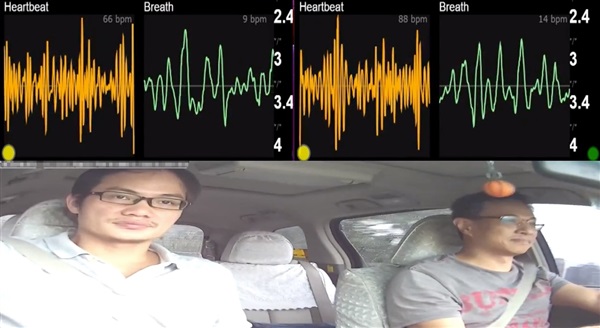 Figure 1 Detecting Driver and Passenger
Vital Signs Using the TI AWR1642 Sensor in a Moving Car (Image Source: AV
Design Solution Corp)
Figure 1 Detecting Driver and Passenger
Vital Signs Using the TI AWR1642 Sensor in a Moving Car (Image Source: AV
Design Solution Corp)In the second example, illustrated in Figure 2, we again used the AWR1642 sensor to demonstrate occupancy detection and vital-sign monitoring of each of the occupants. The sensor is mounted above the rearview mirror and has two transmitters and four receivers. The AWR1843 device, which has three transmitters, four receivers and more memory, enables additional features beyond occupant detection, like basic classification of occupants as an adult or child.
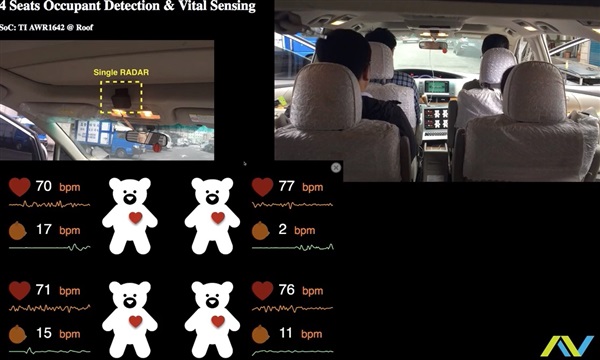 Figure 2 Occupant Detection and
Vital-sign Monitoring of Four Occupants inside a Car Using the AWR1642 Single
Chip Sensor Mounted above the Rearview Mirror (Image Source: AV Design
Solution Corp)
Figure 2 Occupant Detection and
Vital-sign Monitoring of Four Occupants inside a Car Using the AWR1642 Single
Chip Sensor Mounted above the Rearview Mirror (Image Source: AV Design
Solution Corp)Distinguishing Occupants Using Radar
The AWR1843 single-chip sensor is mounted on the roof of the car to accurately detect an occupant and determine whether it is an adult or a child. The classifier software outputs the most probable occupant per seat with high accuracy. Figure 3 and Figure 4 illustrates this classification.
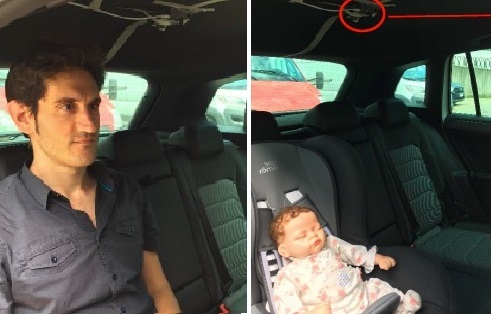 Figure 3 Detecting and Distinguishing
between an Adult and Child Occupant Using the AWR1843 Sensor Mounted on the
Ceiling (Image Source: Azcom Technology)
Figure 3 Detecting and Distinguishing
between an Adult and Child Occupant Using the AWR1843 Sensor Mounted on the
Ceiling (Image Source: Azcom Technology)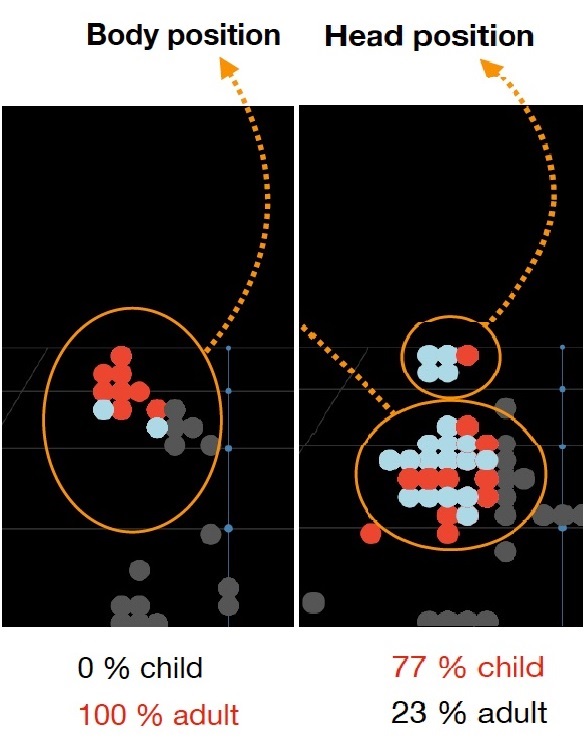 Figure 4 The Output of the AWR1843
Single Chip Sensor Classifier as an Adult or a Child Based on a Probability
Percentage Which Is More than 98% Accurate from Initial Tests (Image
Source: AV Design Solution Corp
Figure 4 The Output of the AWR1843
Single Chip Sensor Classifier as an Adult or a Child Based on a Probability
Percentage Which Is More than 98% Accurate from Initial Tests (Image
Source: AV Design Solution CorpIn-cabin Sensing Using Imaging Radar
To demonstrate in-cabin sensing with imaging radar, we estimated a person’s posture using an evaluation module from one of our partners. The imaging radar module comprises four cascaded mmWave sensors and a TDAx processor, which conducts all processing. An external computer displays the results. Our demonstration is shown in Figure 5.
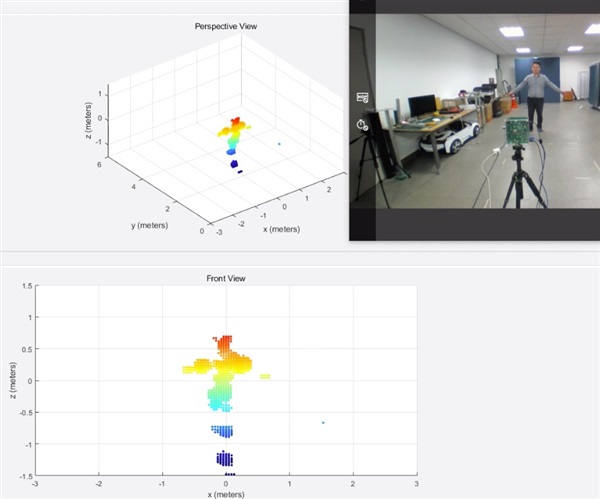 Figure 5 An Imaging Radar Test Setup,
with a Person Standing in Front of the Imaging Radar Module (a); and a
Point-cloud Representation of This Person, with Various Colors Used to Indicate
Height (b) (Image Source: Smart Radar Systems)
Figure 5 An Imaging Radar Test Setup,
with a Person Standing in Front of the Imaging Radar Module (a); and a
Point-cloud Representation of This Person, with Various Colors Used to Indicate
Height (b) (Image Source: Smart Radar Systems)Figure 6 and Figure 7 demonstrate passenger occupancy detection in an SUV-like setup with seven seats. The imaging radar evaluation module is facing downwards, similar to a ceiling position. The radar sensor detects all six passengers in the vehicle accurately. The imaging radar also clearly identifies the empty seat between the other two seats in the back row.
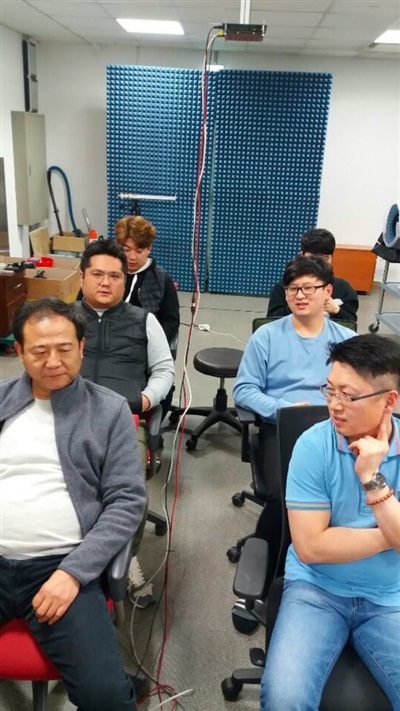 Figure 6 Lab demonstration showing the
detection of all passengers in a car-like setup using TI imaging radar.
Figure 6 Lab demonstration showing the
detection of all passengers in a car-like setup using TI imaging radar.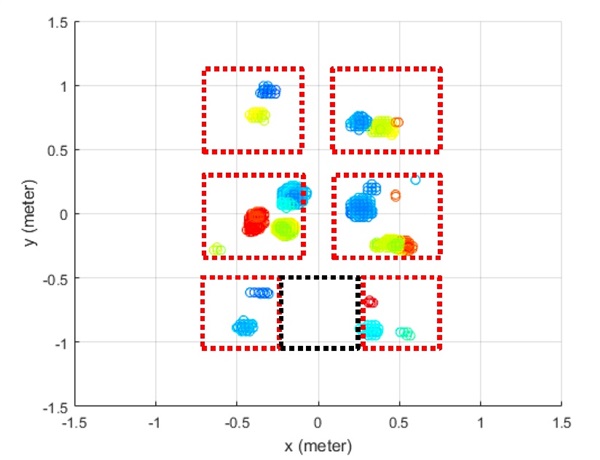 Figure 7 Lab demonstration output where
the red boxes indicate an occupied seat, while a black box indicates an empty
seat. (Image Source: Smart Radar Systems)
Figure 7 Lab demonstration output where
the red boxes indicate an occupied seat, while a black box indicates an empty
seat. (Image Source: Smart Radar Systems)The Benefits of Interior Sensing Solutions with TI mmWave Sensors
TI mmWave sensors provide a reliable and robust option for interior cabin sensing.
When the sensor is installed inside a car, the temperature of the sensor can quickly rise on a hot day. According to automotive standards, the sensor must to be able to operate even at these high junction temperatures. TI mmWave sensors work across a wide temperature range.
In addition, sensor reliability is extremely important for occupant detection. TI mmWave sensors are Automotive Electronics Council-Q100 qualified and TI mmWave sensors help automotive designers achieve Automotive Safety Integrity Level (ASIL)-B requirements for interior sensing systems.
A final, important aspect of a TI mmWave sensor design process is our software, which makes the design scalable and easier at the same time. The mmWave-SDK contains the same drivers and API’s for all of our single chip sensors and imaging radar. We also provide several reference designs and examples to start your design.
Additional Resources
IMPORTANT NOTICE AND DISCLAIMER
TI PROVIDES TECHNICAL AND RELIABILITY DATA (INCLUDING DATASHEETS), DESIGN RESOURCES (INCLUDING REFERENCE DESIGNS), APPLICATION OR OTHER DESIGN ADVICE, WEB TOOLS, SAFETY INFORMATION, AND OTHER RESOURCES “AS IS” AND WITH ALL FAULTS, AND DISCLAIMS ALL WARRANTIES, EXPRESS AND IMPLIED, INCLUDING WITHOUT LIMITATION ANY IMPLIED WARRANTIES OF MERCHANTABILITY, FITNESS FOR A PARTICULAR PURPOSE OR NON-INFRINGEMENT OF THIRD PARTY INTELLECTUAL PROPERTY RIGHTS.
These resources are intended for skilled developers designing with TI products. You are solely responsible for (1) selecting the appropriate TI products for your application, (2) designing, validating and testing your application, and (3) ensuring your application meets applicable standards, and any other safety, security, or other requirements. These resources are subject to change without notice. TI grants you permission to use these resources only for development of an application that uses the TI products described in the resource. Other reproduction and display of these resources is prohibited. No license is granted to any other TI intellectual property right or to any third party intellectual property right. TI disclaims responsibility for, and you will fully indemnify TI and its representatives against, any claims, damages, costs, losses, and liabilities arising out of your use of these resources.
TI’s products are provided subject to TI’s Terms of Sale (www.ti.com/legal/termsofsale.html) or other applicable terms available either on ti.com or provided in conjunction with such TI products. TI’s provision of these resources does not expand or otherwise alter TI’s applicable warranties or warranty disclaimers for TI products.
Mailing Address: Texas Instruments, Post Office Box 655303, Dallas, Texas 75265
Copyright © 2023, Texas Instruments Incorporated